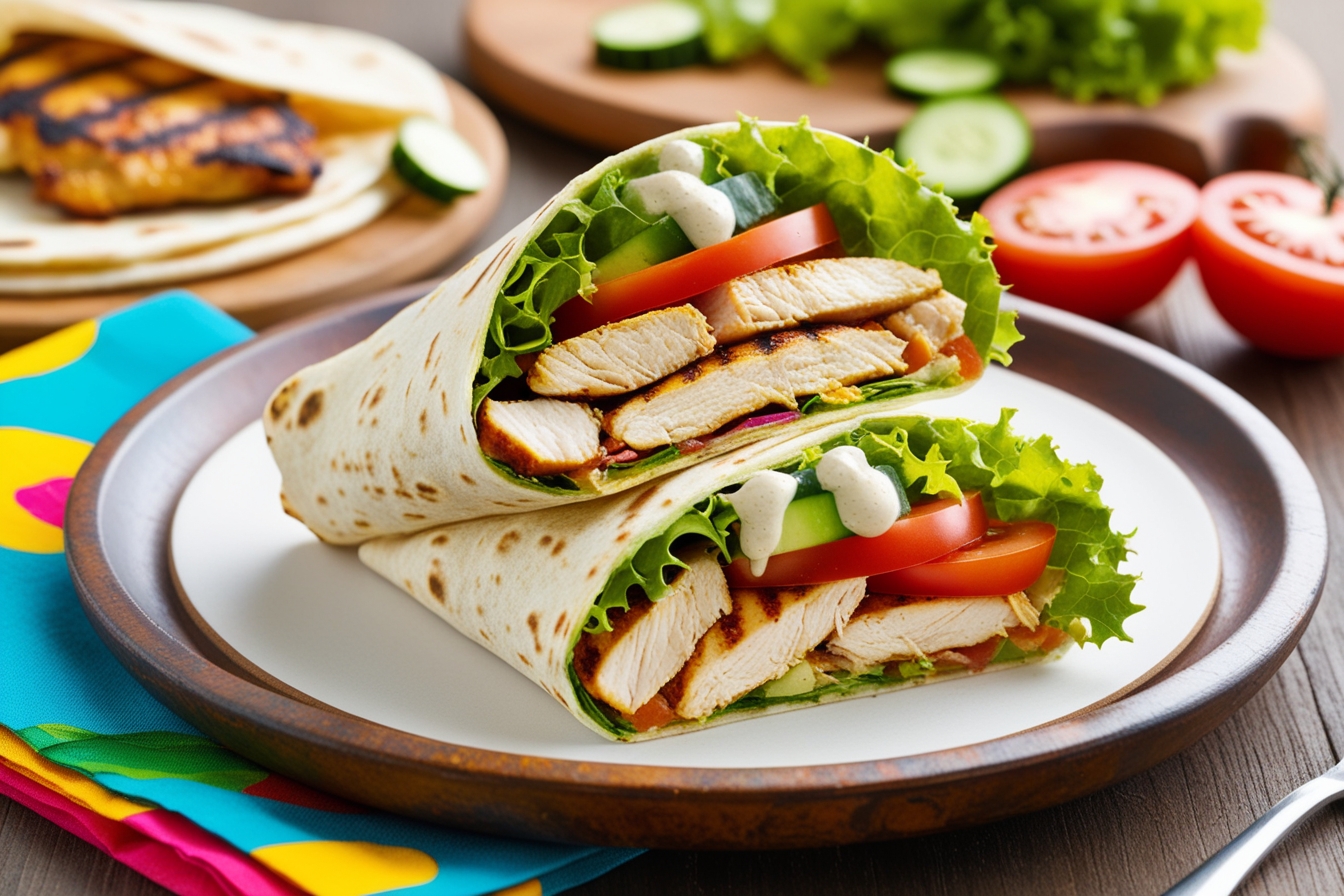Introduction to Grilled Chicken Wraps
What is a Grilled Chicken Wrap?
A grilled chicken wrap is a delectable combination of grilled chicken, crisp vegetables, sauces, and other ingredients, all enveloped in a soft tortilla. It can be a quick lunch, a light dinner, or even a grab-and-go snack. Popular for its portability and customization, this dish has become a staple in cafes and home kitchens alike.
One of the many reasons for its popularity is its adaptability. You can experiment with flavors by changing the type of chicken marinade or tweaking the fillings. With options ranging from spicy and tangy to creamy and mild, there’s always a version to suit your cravings.
History and Origin of Grilled Chicken Wraps
The roots of the grilled chicken wrap are surprisingly global. Although the concept might seem contemporary, its origins trace back to Mediterranean cuisines like shawarma and Greek gyros. These wraps traditionally featured spiced meats and flatbreads. Over time, American influences transformed these recipes into the modern grilled chicken wrap we know today.
From street food vendors to upscale restaurants, wraps gained traction due to their simplicity and customizable nature. With the rise of health-conscious eating, wraps featuring lean proteins like grilled chicken emerged as an ideal option.
Nutritional Benefits of Grilled Chicken Wraps
When it comes to balanced meals, the grilled chicken wrap is a nutritional powerhouse. Grilled chicken is a rich source of protein, essential for muscle repair and overall health. Plus, the inclusion of fresh vegetables like lettuce, tomatoes, and cucumbers boosts the intake of fiber, vitamins, and antioxidants.
The tortilla or wrap itself can be adjusted based on dietary needs. Whole wheat or spinach tortillas add nutrients, while gluten-free options cater to those with sensitivities. With the right sauces and fillings, you can create a meal that’s both tasty and nourishing.
Ingredients and Preparation
Selecting the Right Chicken Cuts
The foundation of any great grilled chicken wrap begins with selecting the right chicken cuts. Boneless, skinless chicken breasts are a popular choice for their lean profile and ability to absorb marinades effortlessly. However, chicken thighs offer a juicier alternative, with their slightly higher fat content providing a richer flavor.
For those looking to maximize convenience, pre-cut chicken strips are an excellent option. But if you’re a stickler for freshness, cutting whole chicken pieces yourself allows greater control over size and thickness. Keep in mind that uniform pieces ensure even cooking and better texture in the final wrap.
Marinating Techniques for Flavor Enhancement
Marinating is the secret weapon in crafting an unforgettable grilled chicken wrap. A well-balanced marinade not only enhances flavor but also tenderizes the meat, making every bite succulent. A classic marinade might include olive oil, lemon juice, garlic, and herbs like rosemary or thyme. Adding a touch of honey or soy sauce introduces a hint of sweetness or umami, depending on your preference.
For a Mediterranean twist, use yogurt, lemon zest, and spices like cumin and paprika. Meanwhile, a Southwest-style wrap benefits from marinades featuring lime juice, chili powder, and cilantro. Remember to allow the chicken to marinate for at least 30 minutes, though an overnight soak yields the best results. If time is short, massaging the marinade into the chicken can help it absorb flavors faster.
Grilling Methods: Indoor vs. Outdoor

Grilling methods play a crucial role in achieving the desired flavor and texture for your grilled chicken wrap. Outdoor grills lend a smoky, charred flavor that’s hard to replicate indoors. Charcoal grills are especially revered for infusing a subtle smokiness, while gas grills offer greater control over temperature.
For indoor options, grill pans or electric grills work wonders. A preheated cast-iron grill pan can mimic outdoor grilling, creating those beautiful sear marks while locking in the juices. Pro tip: brushing the chicken with oil before grilling prevents sticking and enhances browning. Regardless of the method, always ensure the chicken reaches an internal temperature of 165°F for safe consumption.
Choosing the Perfect Tortilla or Wrap
The tortilla you choose can make or break your grilled chicken wrap. Traditional flour tortillas are soft and pliable, making them easy to roll and suitable for most fillings. Whole wheat tortillas, on the other hand, offer a slightly nutty flavor and added fiber, making them a healthier alternative.
If you’re looking for something unique, spinach or sun-dried tomato wraps add a burst of color and complementary flavors. Gluten-free tortillas, often made from corn or cassava flour, cater to those with dietary restrictions. Be sure to warm your tortilla before assembling—it enhances pliability and prevents cracking.
Fresh Vegetables and Additional Fillings
A grilled chicken wrap thrives on the interplay of textures and flavors, and fresh vegetables are key to achieving that balance. Crisp lettuce and cucumbers add crunch, while ripe tomatoes bring a juicy sweetness. For an extra layer of creaminess, avocado slices or guacamole are unbeatable.
Cheese lovers can elevate their wrap with shredded cheddar, feta, or mozzarella. If you’re feeling adventurous, roasted vegetables like bell peppers or zucchini can lend a smoky depth. Remember, the goal is to strike a harmony between the ingredients, so avoid overloading the wrap to maintain its structural integrity.
Sauces and Dressings: Adding the Finishing Touch
The sauce is the unsung hero of any grilled chicken wrap. A good dressing ties all the ingredients together, amplifying flavors without overpowering them. Creamy sauces like ranch dressing or Caesar dressing add richness, while lighter options like tzatziki or hummus keep things fresh.
For those who love a kick, spicy mayo or chipotle sauce delivers the heat. If you prefer tangy notes, consider a balsamic glaze or vinaigrette. The golden rule? Apply sparingly—too much sauce can make the wrap soggy and difficult to handle. A drizzle on the chicken or a thin layer spread on the tortilla usually suffices.
Variations and Serving Suggestions
Popular Grilled Chicken Wrap Variations
One of the most exciting aspects of a grilled chicken wrap is its versatility. By simply adjusting ingredients and seasonings, you can create unique flavor profiles tailored to your preferences. Here are three popular variations:
- Southwest Grilled Chicken Wrap:
This variation is all about bold, spicy flavors. Fill your tortilla with grilled chicken seasoned with chili powder and cumin. Add black beans, corn, and shredded cheese, then drizzle with a zesty chipotle sauce. A squeeze of lime over the top ties the flavors together beautifully. - Mediterranean Grilled Chicken Wrap:
For a fresh and tangy twist, opt for ingredients like hummus, feta cheese, and cucumbers. Marinate the chicken in olive oil, oregano, and lemon juice for a classic Mediterranean touch. Pair with a dollop of tzatziki sauce for extra flavor. - Asian-Inspired Grilled Chicken Wrap:
This fusion option blends grilled chicken with ingredients like shredded carrots, cabbage, and scallions. Toss in sesame seeds and a drizzle of hoisin or peanut sauce for a sweet-savory profile that’s sure to impress.
Serving Grilled Chicken Wraps: Sides and Beverages
The right side dishes can turn your grilled chicken wrap into a complete meal. Light, fresh salads like coleslaw or mixed greens work well to balance the richness of the wrap. For a crunchier pairing, consider baked tortilla chips with a side of guacamole or salsa.
Fruit platters featuring items like watermelon or berries can provide a refreshing contrast to savory wraps. When it comes to beverages, infused water with cucumber or lemon keeps things simple and refreshing. Non-caffeinated herbal teas also pair beautifully, especially if the wrap features spicy flavors.
Storing and Reheating Leftovers
If you find yourself with extra grilled chicken wraps, proper storage is key to preserving their quality. Wrap them tightly in foil or plastic wrap and place them in an airtight container. Store in the refrigerator for up to 3 days.
To reheat, use an oven or toaster oven for best results. Preheat to 350°F, then heat the wrap for 10–15 minutes to maintain its crispness and avoid sogginess. Microwaving is quicker but may soften the tortilla excessively—use this method only if you’re short on time.
For meal preppers, store fillings and tortillas separately to prevent them from becoming soggy. Assemble just before serving to ensure the freshest taste.
Frequently Asked Questions (FAQs)
How can I make a grilled chicken wrap healthier?
Making a grilled chicken wrap healthier is all about smart ingredient choices. Opt for whole wheat or spinach tortillas to increase fiber and nutrient content. Load up on fresh vegetables like spinach, kale, and bell peppers, which are rich in vitamins and antioxidants. Swap creamy sauces for lighter options like Greek yogurt-based dressings or a squeeze of lemon juice. Additionally, using lean chicken breast and controlling portion sizes for cheese and sauce can significantly reduce calories without sacrificing flavor.
What are some vegetarian alternatives for grilled chicken wraps?
Vegetarians can enjoy wraps just as much as meat lovers! Replace grilled chicken with plant-based proteins like marinated tofu, roasted chickpeas, or grilled tempeh. For a heartier option, try filling the wrap with grilled portobello mushrooms or a combination of black beans and quinoa. Incorporate flavor-packed sauces, like hummus or avocado spread, to tie the ingredients together.
Can I freeze grilled chicken wraps for later use?
Yes, grilled chicken wraps can be frozen for meal prep or storage. However, for the best results, freeze the components separately. Place the cooked and cooled chicken in a freezer-safe container and use plastic wrap to keep the tortillas fresh. Avoid freezing raw vegetables or sauces as they can lose texture upon thawing. When ready to assemble, thaw everything in the refrigerator, reheat the chicken, and add fresh toppings.
What are the best cheeses to use in a grilled chicken wrap?
The choice of cheese depends on your flavor preferences. Shredded cheddar or mozzarella melts well and provides a creamy texture. Feta cheese adds a tangy, salty kick, making it ideal for Mediterranean-inspired wraps. For a smoky twist, consider gouda or smoked provolone. Remember, a little goes a long way—too much cheese can overpower the other ingredients.
How do I prevent the wrap from becoming soggy?
Sogginess is a common issue, but it’s easy to avoid with a few tricks. First, pat the grilled chicken dry before placing it in the wrap. Use sturdy greens like romaine or kale as a barrier between the tortilla and wetter ingredients like tomatoes or sauces. Apply sauces sparingly and only right before serving. Wrapping the finished product tightly in parchment paper also helps maintain structure.
What are some low-carb wrap options?
For those following a low-carb diet, there are plenty of alternatives to traditional tortillas. Lettuce leaves, such as iceberg or romaine, make excellent wraps while adding crunch. Egg wraps or almond flour tortillas are also great low-carb options that provide flexibility without compromising taste. Cauliflower wraps or coconut wraps are worth exploring for unique textures and flavors.
If you’re craving a sweet and savory chicken dish with an Asian twist, check out our recipe for Panda Express Honey Sesame Chicken.

